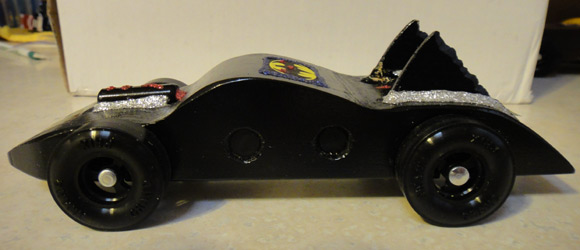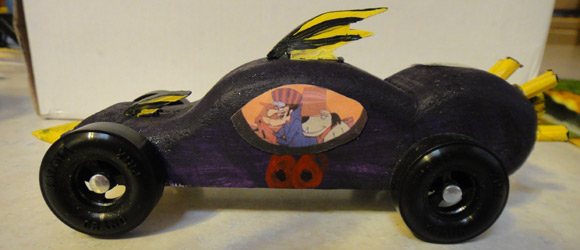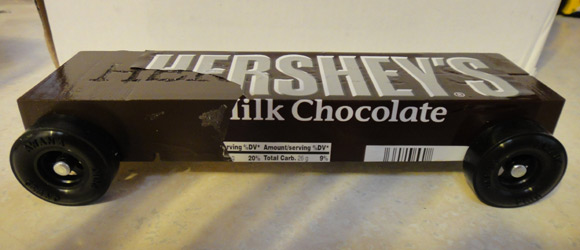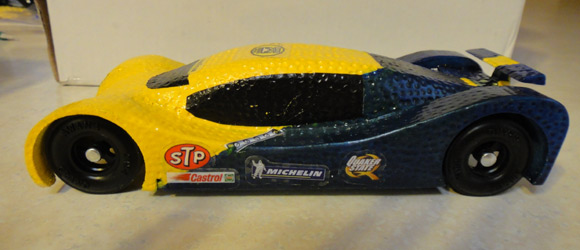– Feature Article – Weigh-in Problems and How to Avoid Them
– Pinewood Derby Car Showcase
– Q&A
Weigh-in Problems and How to Avoid Them
By Randy Davis
(An update of an article originally published February 23, 2005)
I have been the head race official for many pinewood derby races. One of the tasks is to manage the check-in process (which really means “do everything you can’t find someone else to do!”). As I have helped kids and parents check-in I repeatedly see the same major mistakes. It doesn’t seem to matter whether we have workshops, pass out detailed instructions, or pass out simple instructions; the same mistakes appear each year.
In today’s article, I will identify the main issues that arise at weigh-ins, and suggest some ways to remedy these problems. My intent is to provide race officials with some ideas as to how to deal with these issues, and to help pinewood derby “freshmen” to ensure these problems don’t occur with their car.
Note To Race Officials
If at all possible coach the car owners to make their own adjustments (after all, it’s their car). If at all possible, don’t put yourself in the position of working on the car yourself, as damage can easily occur. When it is apparent that you will need to work on the car, ask the car owner if they will permit you to work on the car. Then tell the owner that you will do your best, but that the car may be damaged.
Car Is Significantly Under Weight
This is the most common problem that occurs. Oftentimes, new car builders do not understand that weight must be added to the car in order to make the target weight.
The only reasonable way (i.e., without risk of damage to the car) to add 2 or 3 ounces of weight to a car after it is painted and assembled is to attach a FlexWeight under the car (available from Maximum Velocity).
Officials – These plates typically sell for about $3.49. So consider purchasing a few and then selling them to the folks that bring in light-weight cars.
Owners – Before doing any work on the car, decide how weight will be added to the car, and then create any needed weight holes/pockets first. This will eliminate lots of grief at the weigh-in.
Car Is Not Lubricated
This is the second most common problem I have seen. I used to be very concerned about this and would work with folks to get some lube on their car. But it is very difficult (and messy) to effectively lubricate after the car is assembled. So, in recent years, I just ask them if they want to add lubricant, and then loan them a tube of graphite if they say yes.
Officials – Have a few tubes of graphite on hand, and identify a location where the race owners can use graphite (typically outside the building).
Owners – Lubricate the wheels and axles before putting them on the car.
Car Is Significantly Over Weight
I’ll never forget the Bus. The family glued another block of wood on top of the original block and then carved and painted the body to look like a school bus. The only problem was that the second block of wood was not pine, but was instead fir, a much denser type of wood. The Bus weighed over 7 ounces! To make the car legal, the dad had to hollow out a large portion of the vehicle.
The point is that depending on what is used for weight, removing more than a few tenths of an ounce can be a difficult problem.
Officials – The method to remove weight depends on the type of weight:
- Lead – Remove lead with a drill and drill bit. Lay the car on a clean rag, and slowly drill into the weight area. Collect and properly dispose of the lead fragments.
- Hard metals embedded in body (steel, tungsten, zinc) – Avoid drilling into hard metals. The amount of pressure required to remove material will likely damage the car. Instead, try to drill around the weight and then use a small chisel to pry out individual weights.
- Zinc plates – Remove the zinc plate, and snap off pieces of the weight with pliers. Weigh the material before reattaching.
Owners – Weigh the car body along with the weight, wheels, axles, and any accessories early in the process. This will allow time to make any needed weight corrections.
Weight Hangs Too Far Below The Car
Typically clearance problems occur due to weights attached to the bottom of the car. In one recent case at our weigh-in, a zinc plate was screwed onto the bottom of the car with the wrong type of screws (the original screws were lost). The weight itself cleared, but the screws didn’t.
Officials – Make sure to check for car clearance. If the car just barely does meet the specification, and you know that there is plenty of clearance on the track, you can choose to let the car race.(1) But if the car clearance is far from the specification, make sure the problem is fixed. Otherwise, the car may drag, scratching the track and performing poorly.
Owners – Make sure your car meets the specification before coming to the weigh-in.
Car Is Oversized
At one of our races, a family came to the weigh-in that had not previously registered (so they had not been given a copy of the rules). Their car (actually a boat) was really neat! It was nicely detailed, but had a mast and a bowsprit (a spar projecting from the bow of a vessel) that caused the car to be too tall and too long. We decided to allow the parts to stay on for the design judging, as long as the parts could be easily removed by the race officials prior to the racing. We have also done this for a few other cars with tails and other accessories.
Officials – Make sure that the rules clearly define what is allowed, and provide the rules to all participants. Then enforce the rules. You may want to clarify in the rules whether accessories can be added for the design judging that cause the vehicle to exceed the size limit.
Owners – Make sure your car meets the specifications before coming to the weigh-in.
Gorilla Glue
Gorilla glue is a relatively new type of construction cement. It is activated by moisture in the air or on the surface to be glued. When it is activated, it foams and expands. This probably works well for construction, but is generally a disaster for pinewood derby cars.
At a recent weigh-in a family brought in three completed cars, all of which had Gorilla glue foam on the wheels. Apparently, they used it to glue the axles in the slots, but then later found that the glue essentially took over the car! I gave them some replacement wheels and axles, and they did their best to repair the cars.
Unfortunately, the family brought along the bottle of glue, and someone else used it to glue tungsten cylinders into holes drilled in the bottom of the car. They turned in the car, and we left if lying on its back for the glue to dry. As the evening progressed, the tungsten cylinders slowly rose out of the holes. I shoved them back in a few times, and finally they stayed in. But if I had not been watching the car, the glue would have cured with the cylinders extending out about a 1/2 inch, and the car would not have been able to run.
Officials – Ban Gorilla Glue from the weigh-in.
Owners – Don’t use Gorilla Glue on your car.
Conclusion
The issues that can arise at weigh-ins are certainly many, and not all of them can be anticipated. But as an official or owner, preparing for these common issues will facilitate a smooth and (relatively) painless weigh-in.
1For our race, we allow zinc plates and FlexWeights to be attached to the bottom of the car, even if the clearance specification is not quite met. I know that cars with this type of weight will run fine on our track. These plates are very convenient for correcting weight issues at the weigh-in, and banning them would be like shooting yourself in the foot.
Pinewood Derby Car Showcase
Today’s showcase cars are from Maynard Hinton.
Batmobile & Dick Dastardly – Samantha Hinton

My daughter Samantha’s Batmobile took first in design and speed. The next year her second car, Dick Dastardly, took first in design and second in speed (by only 1 thousandth of a second).
Hershey Bar – Terie Hinton
Out of all the cars my wife Terie has made, the Hershey bar had the best results. It took both second in speed and design in the adult division at our Awana Grand Prix.
The Mythbuster – Maynard Hinton
I made this car from a design I saw at a derby car building class. I went the next step further after watching MythBusters when they showed how a golf ball would fly farther and faster because of the dimples that are on the ball. So I used my Dremel tool to make dimples all over the car to test that theory. Unfortunately, I had to shave the inside of the fenders because they were rubbing on the rails. Long story short, the car was pretty quick, but not as fast as I had hoped because I got sawdust in the front axles from the late modification.
Q&A
The past several years I have used your 4094 BSA speed axles without issues, and with pretty solid performance. I am considering using the 4093 Super speed axles. Do they provide a performance advantage over the 4094 axles?
Due to the larger diameter, the 4093 axles will generally outperform the 4094 axles. You can read about a test I did on these axles. The article is entitled “Grooved Speed Axles”, but I tested both grooved and non-grooved. The 4093 axles are the “Oversized Non-Grooved Axles”
Do you know where I can get some of the wheels that were on the original kits – from the late 50s?
I would check eBay, as the vintage kits occasionally show up there. A similar wheel is sold by S&W Crafts. It is not identical, but close.
Want Answers?
Do you have a pinewood derby-related question? If so, e-mail us your question.We answer all questions by e-mail, but not every question will appear in the Q&A section of the newsletter.
Back Issues
Are you a new subscriber, or have you missed some of the previous newsletters? Don’t miss out; all of the issues for Volume 5 through Volume 17 are posted on our web site.
Newsletter Contributions
We welcome your contributions. If you would like to contribute an article, a web site review, a speed tip, or a pinewood derby memory, please e-mail us.
Subscription Information
The Pinewood Derby Times is a free e-newsletter focused on pinewood derby racing. It is published biweekly from October through March.
If you haven’t already done so, please forward this issue to your pinewood derby friends. But please don’t subscribe your friends. Let them decide for themselves. Thanks.
If this newsletter was forwarded to you, why not subscribe to receive this newsletter. There is no cost, and your e-mail address is safe, as we never sell or share our distribution list.
To subscribe, send a blank e-mail to
[email protected]
You will receive a confirmation e-mail. Reply to the confirmation e-mail and you will start receiving the Pinewood Derby Times with the next issue.
Randy Davis, Editor, Pinewood Derby Times
E-Mail: [email protected]
(C)2018, Maximum Velocity, Inc. All rights reserved. Please do not reprint or place this newsletter on your web site without explicit permission. However, if you like this newsletter we grant permission, and encourage you to e-mail it to a friend.
Maximum Velocity disclaims any personal loss or liability caused by utilization of any information presented in this newsletter.
The Pinewood Derby Times is not specific to, and is not affiliated with the Boy Scouts of America, YMCA, Awana, or any other organization.
(R)Maximum Velocity is a registered trademark of Maximum Velocity, Inc.
(R)Pinewood Derby is a registered trademarks of the Boys Scouts of America.
(R)Awana is a registered trademark of Awana Clubs International.
All other names are trademarks of their respective owners.



